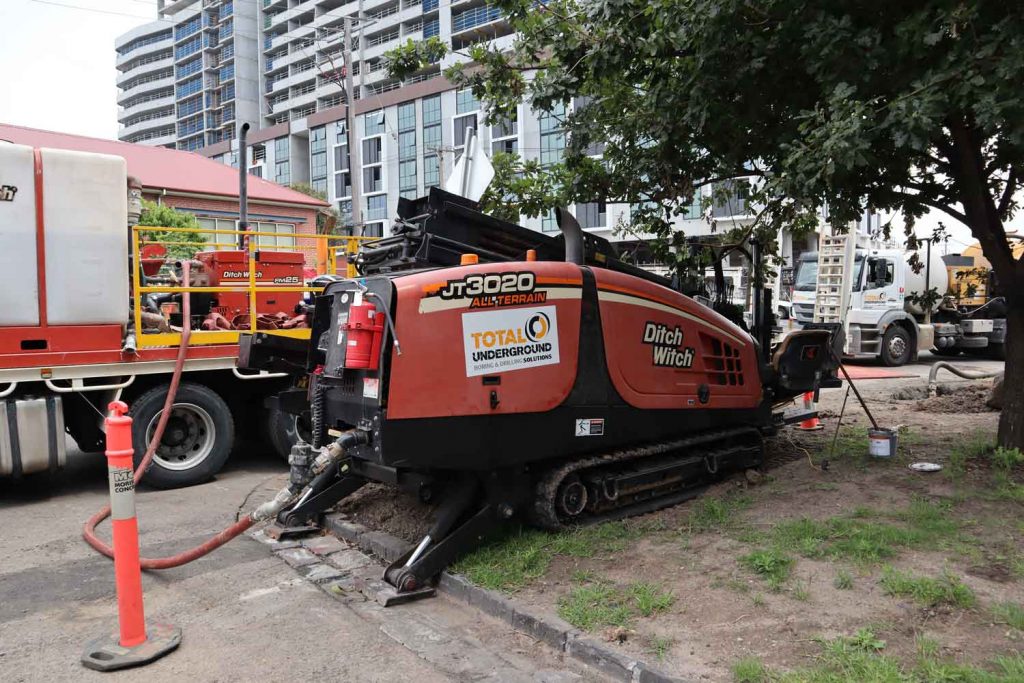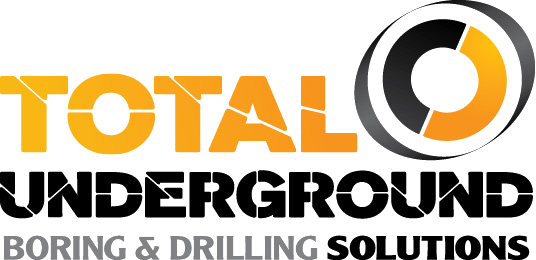Using an advanced trench less system that is also steerable, means that a highly accurate underground bore can be made that avoids previous drilling obstacles and gives you access to the best path for your infrastructures.
What is Horizontal Directional Drilling?
Often referred to as horizontal boring, horizontal directional drilling (HDD) is a surface to surface drilling method of laying cables or pipes underground whilst avoiding any obstacles that would usually prevent drilling to occur. This trenchless technology also allows for connections to be made that are not necessarily in a straight line.
The pilot bore is tracked by the operator with a beacon and so can avoid common obstacles including roads, footpaths, railroads, driveways or rivers. Horizontal directional drilling is suitable for many different soil types and applications that go well beyond simple drilling under roads or boring under driveways.

Our horizontal directional drilling machine pre-reaming a borehole
Choose the Horizontal Directional Drilling Experts
Total Underground Solutions have more than two decades of experience in horizontal directional boring across Melbourne. To discuss how we can help with your horizontal directional drilling project, contact us on 1300 926 112 or submit an inquiry now.
How does Horizontal Directional Drilling Work?
The horizontal directional drilling process can be broken down into three stages. Unlike other drilling methods, directional boring only requires a small setup area to house the drilling equipment.
Stage 1 – Horizontal drilling the pilot bore
Once the site has been safely setup, drilling of the pilot hole begins at the entry of the design path. Horizontal drilling continues along the design path and is expertly steered with the aid of a beacon behind the cutting head.
Simultaneously, drilling fluid is pumped to the cutting head and combined with high pressure water to assist the cutting head in breaking down the soil ahead. The slurry created as a result of the horizontal directional drilling is fed back to the entrance site, ensuring the pilot hole is kept clear.
Stage 2 – Pre-reaming the borehole
The pilot hole has been drilled, however the drilling hole must be widened to allow room to lay the required cable or piping. A reamer is operated to enlarge the diameter of the horizontal boring. The reamer is usually attached to the drill string on the exit side of the hole and pulled pack (pre-reaming). Like in the first stage of the HDD process, a slurry is fed to assist in clearing cuttings while also keeping the borehole stable.
Stage 3 – Pipe pullback
Now that drill hole has been widened, the conduit is ready to be laid. The prefabricated pipeline is attached to a reamer at the exit point and pulled back through the directionally drilled borehole. The drill rod and reamer are attached to a swivel, reducing torsion stress transferred from the drill to the product pipe. Once the reamer reaches the entry of the hole, the pipeline is now in place to lay the conduit.
Advantages of Horizontal Directional Drilling
Horizontal directional drilling has become the favoured drilling method for underground pipeline or cabling installation due to the significant cost savings that come with it. Benefits of HDD include:
- Faster installation of the conduit as the process doesn’t require a borehole to be dug vertically then horizontally like in traditional open cut drilling. Post drilling, there is also less dirt to remove and rebury saving additional time.
- Less disruption of the landscape as less soil is displaced in the horizontal drilling process.
- Drilling flexibility as previous obstacles can now be manoeuvred around. This allows for new drilling locations that previously were inoperable or projects that were too expensive.
- Reduced soil contamination as soil is pushed to the side rather than excavated in traditional drilling methods. As the soil is kept underground and not surfaced, contamination is reduced.
- Traffic control and disruption are also reduced, as there is less above ground disruption, making horizontal directional drilling an ideal drilling solution for built up urban areas.
